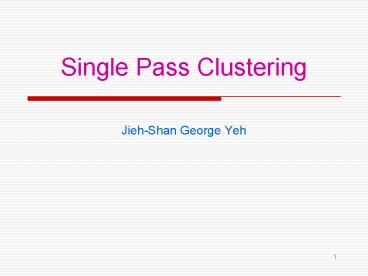Single Pass Clustering - PowerPoint PPT Presentation
1 / 10
Title:
Single Pass Clustering
Description:
Now, there is only one cluster, C1, so we only need to compare T3 ... Therefore, we use T3 to start a new cluster, C2. Now we have two clusters. C1 = {T1, T2} ... – PowerPoint PPT presentation
Number of Views:216
Avg rating:3.0/5.0
Title: Single Pass Clustering
1
Single Pass Clustering
- Jieh-Shan George Yeh
2
Example
- Consider the set of documents and terms
- Clustering the terms using the single pass method
(using the term vector columns)
3
Preliminary
- Order the term vectors (column vectors).
- Choose a simplicity function, say, dot product.
- Set a pre-specified similarity threshold 10.
4
Step 1
- Start with T1 in a cluster by itself, say C1.
- At this point, C1 contains only one item, T1.
- the centroid of C1 is simply the vector for T1
C1 lt1, 3, 3, 2, 2gt.
5
Step 2
- Now compare (i.e., measure similarities) of the
next item (T2) to centroids of all existing
clusters. - SIM(T2, C1) lt2, 1, 0, 1, 2gtlt1, 3, 3, 2, 2gt 21
13 03 12 22 11 gt10 - Add T2 to cluster C1.
- Compute the new centroid for C1 (which now
contains T1 and T2). - The centroid (which is the average vector for T1
and T2 is - C1 lt3/2, 4/2, 3/2, 3/2, 4/2gt
6
Step 3
- Now, there is only one cluster, C1, so we only
need to compare T3 with C1 centroid. - SIM(T3, C1) 0 8/2 0 0 4/2 6 lt10
- Therefore, we use T3 to start a new cluster, C2.
- Now we have two clusters
- C1 T1, T2
- C2 T3
7
Step 4
- Move to the next unclustered item, T4.
- SIM(T4, C1) lt0, 3, 0, 3, 5gtlt3/2, 4/2, 3/2, 3/2,
4/2gt 0 12/2 0 9/2 20/2 20.5 gt10 - SIM(T4, C2) lt0, 3, 0, 3, 5gt lt0, 2, 0, 0, 1gt 0
6 0 0 5 11gt10 - SIM(T4, C1) gt SIM(T4, C2)
- T4 will be added to cluster C1. Now we have the
following C1 T1, T2, T4 C2 T3 - The new centroid for C1 is now
- C1 lt3/3, 7/3, 3/3, 6/3, 9/3gt
8
Step 5
- The only item left unclustered is T5.
- SIM(T5, C1) lt1, 0, 1, 0, 1gt lt3/3, 7/3, 3/3,
6/3, 9/3gt 3/3 0 3/3 0 9/3 5 lt10 - SIM(T5, C2) lt1, 0, 1, 0, 1gt lt0, 2, 0, 0, 1gt 0
0 0 0 1 1 lt10 - T5 will have to go into a new cluster C3.
9
Final
- The final clusters are
- C1 T1, T2, T4
- C2 T3
- C3 T5
10
Note
- The results for this method are highly dependent
on the similarity threshold. - The results are also are highly dependent on the
order of vectors. - The computation complexity is O(nk), where n is
the number of vectors and k is the number of
classes.

